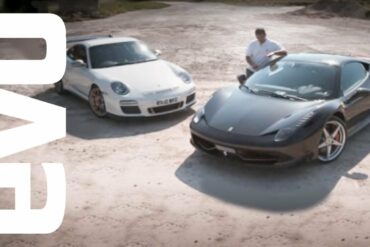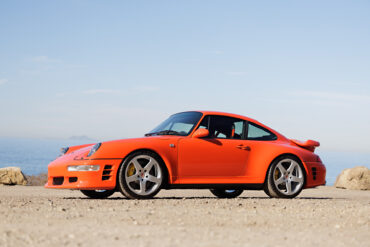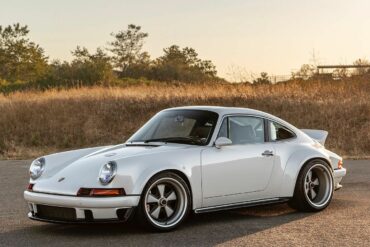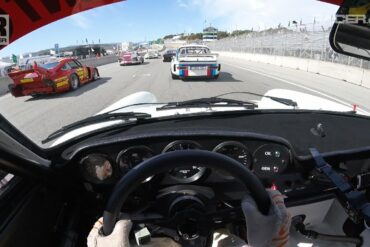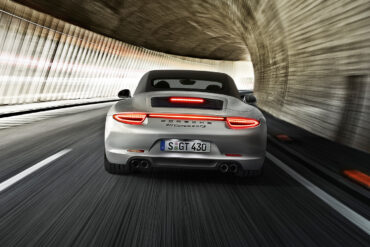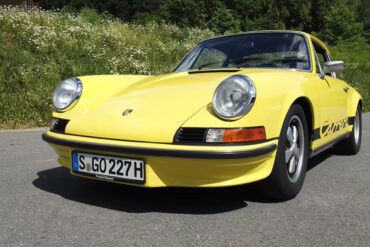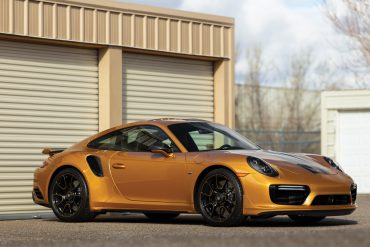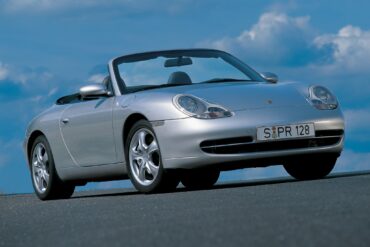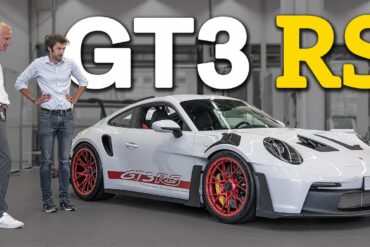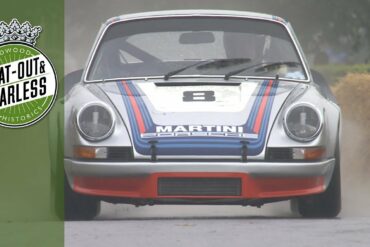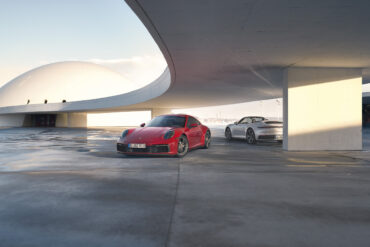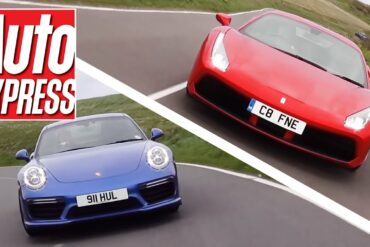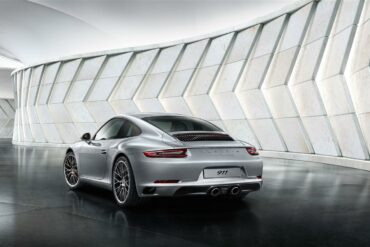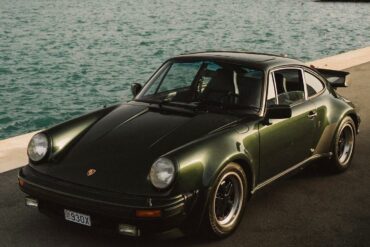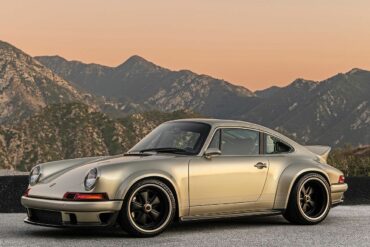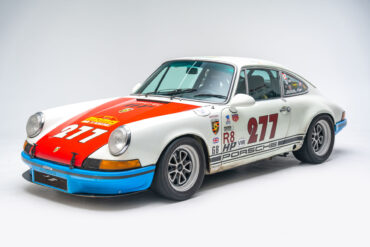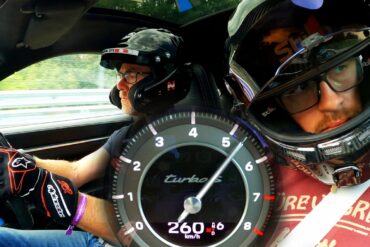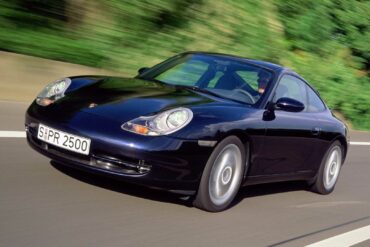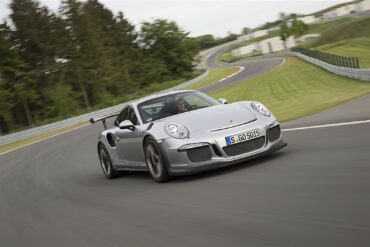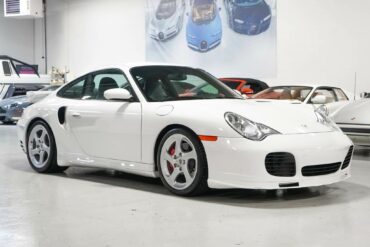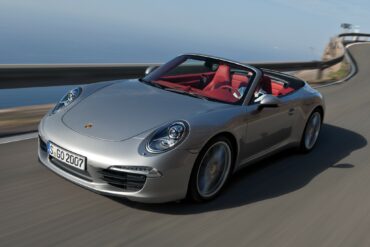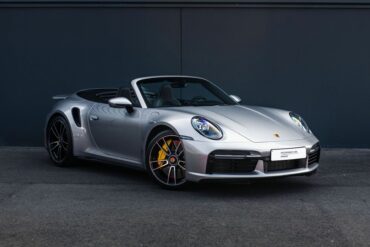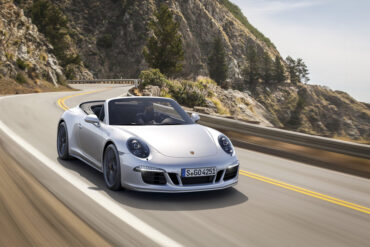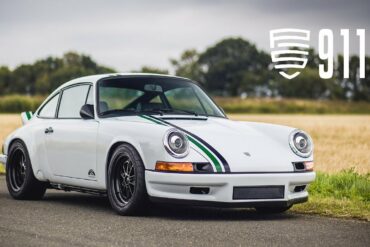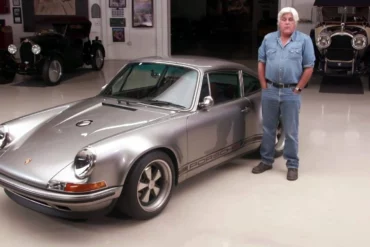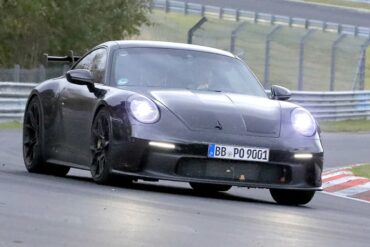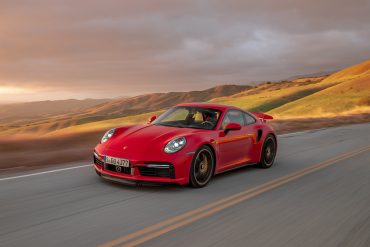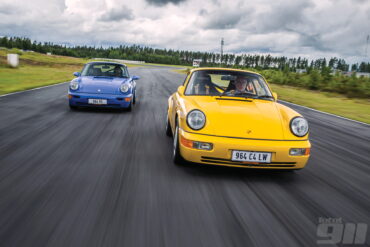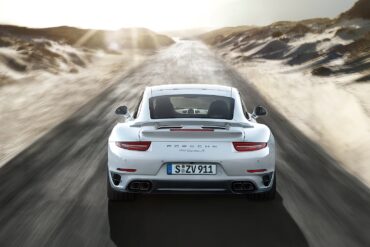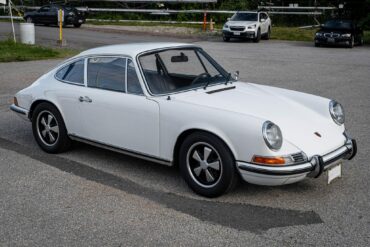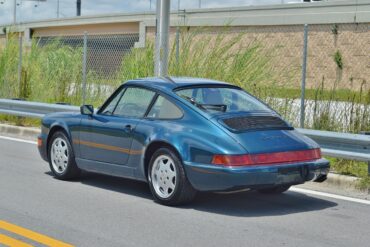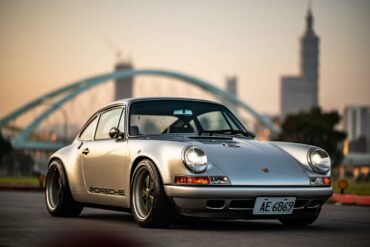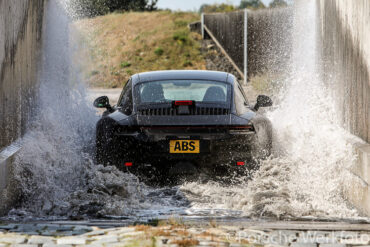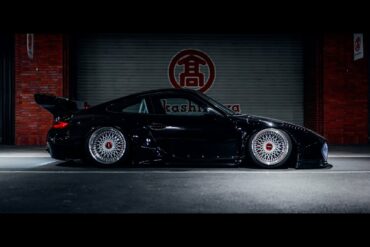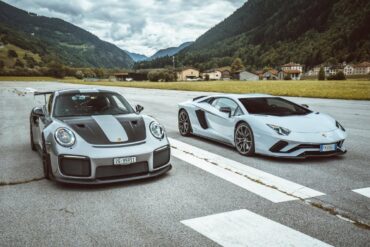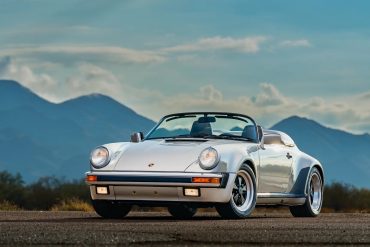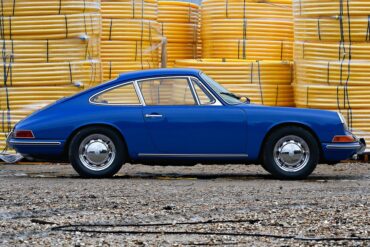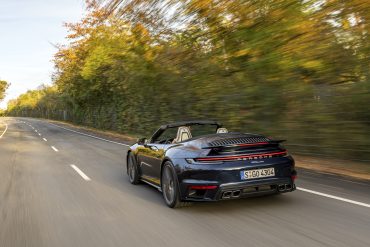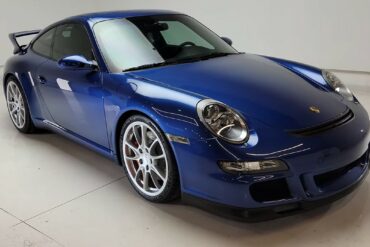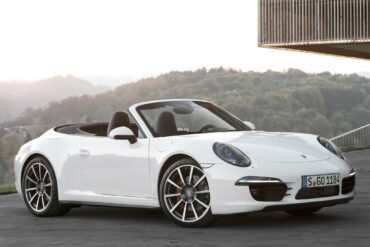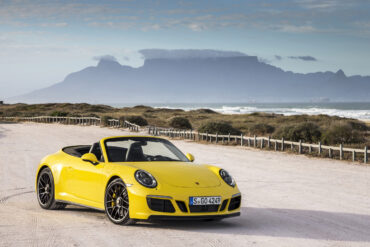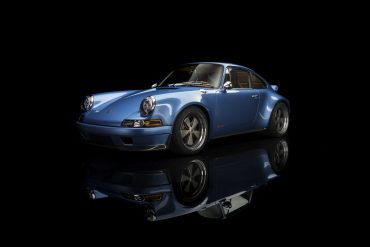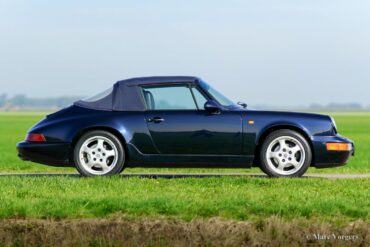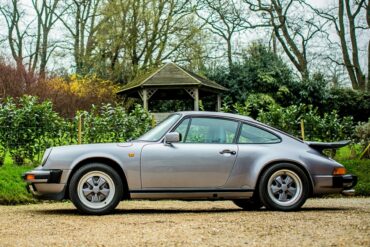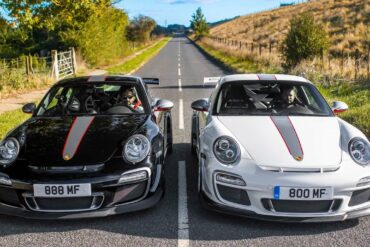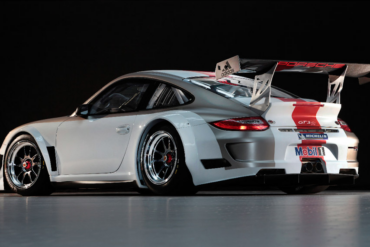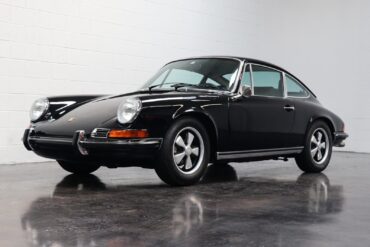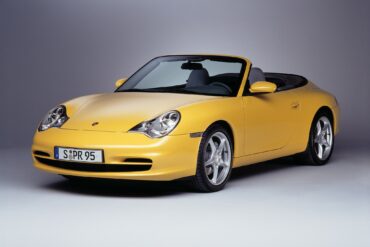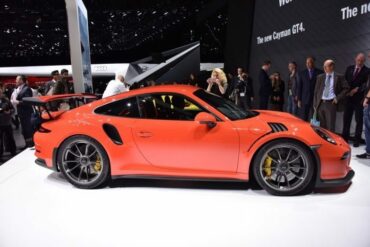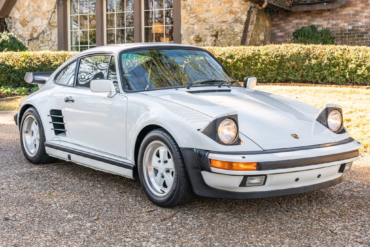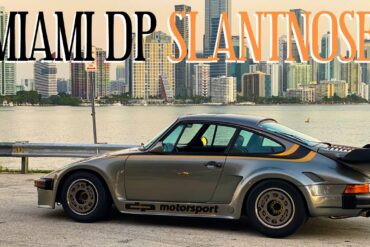The 993 Turbo S, available between 1997 and 1998, bumped the power from the standard 993 Turbo up to 450hp (430 for the United States market) with larger turbochargers and a modified engine management system. The Turbo S was fitted with more luxury trim bits on the interior – with more leather and carbon fiber than on the standard Turbo. A larger rear wing was installed as well. Only 345 were built. Its direct successor was the 996 Turbo S for model year 2005.
Porsche 911
All
- Porsche 912
- 911 Carrera RS 2.7
- Porsche 901 (911)
- Porsche 911 (F-Series)
- Porsche 911 (991)
- Porsche 911 (G-Series)
- Porsche 911 (964)
- Porsche 911 (993)
- Porsche 911 (996)
- Porsche 911 (997)
- 911 Speedster Concept
- Porsche 911 (992)
- 964 Carrera 2
- 964 Carrera 4
- ’30 Jahre’ Anniversary
- 964 Speedster
- 964 Turbo
- 964 Carrera RS
- 964 Carrera Cup
- 964 RSR
- 993 Carrera
- 993 Carrera 4
- 911 Edition 50
- 993 Carrera 4S
- 911 2.0 Bertone Roadster
- 993 Carrera S
- 993 Targa
- 992 Sport Classic
- 993 Turbo
- 996 Carrera
- 993 Carrera RS
- 992 America Edition 911
- 996 Carrera 4
- 993 GT2
- 996 Targa
- 993 Carrera Cup
- 996 Carrera 4S
- 996 Turbo
- 996 Turbo S
- 996 GT3
- 996 GT3 RS
- 996 GT2
- 996 GT3 Cup
- 996 GT3 R
- 996 GT3 RSR
- 997 Carrera
- 996 GT3 RS Race
- 997 Carrera S
- 997 Carrera 4
- 997 Carrera 4S
- 997 Targa
- 911 Carrera 3.0 Coupe (G-Series)
- 997 Targa 4S
- 997 Turbo
- 997 Turbo S
- 997 GT2
- 992 Carrera T
- 997 GT2 RS
- 997 Speedster
- 997 Carrera GTS
- 992 Dakar
- 997 Carrera 4 GTS
- 997 GT3 Cup
- 997 GT3 R
- 997 GT3 RSR
- 997 GT3
- 997 GT3 RS
- 997 GT3 R Hybrid
- 991 Carrera
- 991 Carrera 4
- 991 Carrera S
- 991 Carrera 4S
- 991 Targa 4
- 991 Targa 4S
- 991 Turbo
- 991 Turbo S
- 991 Carrera GTS
- 991 Carrera 4 GTS
- 991 Targa 4 GTS
- 991 911 R
- Porsche 992 GT2 RS
- 991 GT3
- 991 GT3 RS
- 991 GT2 RS
- 991 Speedster
- 991 GT3 R
- 991 GT3 Cup
- 991 RSR
- 991 Carrera T
- 992 Carrera 2
- 992 Carrera 4
- 992 Carrera S
- 992 Carrera 4S
- 992 Targa 4
- 992 RSR
- 992 Targa 4S
- 992 Carrera GTS
- 992 Carrera 4 GTS
- 992 Targa 4 GTS
- 992 Turbo
- 992 GT3 R
- 992 Turbo S
- 992 GT3
- 992 GT3 Touring
- 992 911 S/T
- 911 (G-Series)
- 992 GT3 RS
- 992 GT2 RS
- 992 GT3 Cup
- 911 Carrera 3.0 (G-Series)
- 911 S (G-Series)
- 911 Carrera RSR 2.8
- 911 SC (G-Series)
- Porsche 992 GT3 R Rennsport
- 911 S/T
- 911 Carrera 3.2 (G-Series)
- 911 (Base Model)
- 911 Turbo (930)
- 911 SC Safari
- 911 L
- 911 Carrera RSR Turbo 2.1
- 911 T
- 911 Carrera RSR 3.0
- 911 E
- 911 S
- 911 SC San Remo
- 911 Carrera 3.2 Clubsport
- 911 R
- Porsche 953
- 911 Carrera RS 3.0
- 911 T/R
- 911 Carrera 25th Anniversary
- 911 SC RS
- 911 Turbo LE
- 911 Carrera Commemorative
- 911 Carrera 2.7 (G-Series)
- 911 3.2 Speedster
- 911 Turbo 2.7
- 964 Turbo S
2020 – Present Porsche 911 Carrera Cabriolet (992) Pictures & Gallery...
Chris Harris Drives The Ferrari 458 Italia & Porsche 911 GT3 RS Ferrari’s latest 562bhp V8 coupe has changed the...
Santa Monica, California: Global market leader and renowned auction house, Gooding & Company, has announced RUF//The Collection consisting of four...
Named “Thing 1” by its owner, this car showcases a Parallax White exterior with a Black interior. Utilizing Computational Fluid...
2021 – Present Porsche 911 Carrera 4 GTS Cabriolet (992) Pictures & Gallery...
Built to homologate the 2011 GT3 RSR racecar, the RS 4.0 is fitted with the 3996cc engine which raises power output...
A short review and comparison of the new Porsche 911 Carrera T from Chasing Cars....
POV Drive In A Porsche 911 3.0 Carrera RSR Factory Porsche racer Patrick Long has a million-dollar historic 911 3.0...
2016 Porsche 911 Carrera 4 GTS Cabriolet (991) Technical Specifications Engine layout Rear Engine Engine type Boxer-6 Cylinders 6 Valves...
It was the first motorsport team-designed consumer grade car, first 911 with a staggered stance, and first factory-installed fixed wing....
Singer Vehicle Design was founded in 2009 with the purpose of preserving the legendary air-cooled Porsche 911. The level of...
Drag Race, Road & Track Review The 2021 Porsche 911 Turbo S ($262,350 CAD, $233,830 USD as specced) and the...
All Images by: Virtual Motorpix/Glen Smale and Corporate Archives Porsche AG In the 2023 Le Mans 24 Hour race, the...
With a limited production of just 500 units worldwide, the 991.2-generation Porsche 911 Turbo S Exclusive Series lives up to...
Daytona 24 Hours, 3-4 February 1973: The start 1973 Daytona 24 hours led by John Watson in the Mirage on...
2018 – 2019 Porsche 911 GT3 RS (991.2) Pictures & Gallery ...
M5 vs 911 Turbo Drag Race The 2022 BMW M5 CS ($170,800 CAD as specced, ~$143,000 USD) is an absolute...
The 996 Cabriolet was introduced in March 1998 at the Geneva Motor Show. The 996 Cabriolet was long ready (remember, it was tested already in 1995), but for marketing and production-related reasons it was launched in 1998 as a 1999 model. While the evolution with the 911 coupe was questionable from 993 to 996, the real evolution came with the cabriolet. In USA - the biggest market - 911 Cabriolets outsold the Coupés. The all-wheel-drive system provides between 5-40% of torque to the front wheels depending on the situation.
The newest 911 GT3 RS is the complete package: gorgeous design, lightweight body, the most advanced aerodynamics, with impeccable performance...
The New Porsche 911 GT3 RS is here and Andreas Preuninger takes Henry Catchpole thorough every single detail....
Live on Bring A Trailer is a low mileage example of a 2024 Porsche 911 GT3 RS that’s been specified...
1972 – 1973 Porsche 911 T 2.4 Targa (LWB) Pictures & Gallery...
If the 996.1 911 GT3 was all about the engine, in the 997.1 completes the rest of the formula. The surgical clarity of its transmission, steering, brakes, pedal weights and heights, and overall chassis balance represented a clear step-change from its regular 997 911 siblings. But the engine was still the heart of the car, the water-cooled 3.6-liter flat-six boasting a new intake and a new exhaust compared with the 996 versions. Official output was 415 hp, though insiders admit some engines made close to 430 hp. Launched in 2006, today this is in many ways the sweet-spot GT3, way more affordable than the later 4.0.
On Board Hot off the heels of the unveiling of the new Porsche 911 RSR, we’re looking back with the...
Broad Arrow’s All-Porsche auction will take place with Air|Water on Saturday, April 27th, and feature approximately 70 Porsches similar to...
2020 – Present Porsche 911 Carrera 4 Cabriolet (992) Pictures & Gallery...
Turbo supercars fight it out The Ferrari 488 GTB is the first turbocharged, mid-engine Ferrari since the legendary F40 in...
2018 Porsche 911 Carrera S Coupe (991.2) Technical Specifications Engine Engine layout Rear Engine Engine type Boxer, twin-turbo Cylinders 6 Valves...
The Autoart 993R is a tribute to the driving experience of a 911. It brought together the narrow-bodied, air-cooled 993-series...
The 930 Turbo with its 3.0 L turbocharged flat 6 was the fastest production car in the world at the...
Listen to this Porsche 992 GT3 fitted with a full Akrapovic exhaust system....
The GT3 Touring model has gained recognition among dedicated driving purists and longstanding Porsche enthusiasts. It offers a more reserved...
Singer Vehicle Design – Caroline Commission Today, we take a closer look at the Singer Vehicle Designs Caroline Commission. First...
Reviewed & Edited by Rex McAfee Only in SoCal: The Urban Outlaw Last year, to commemorate the 10th anniversary of...
The 992 Turbo S comes with an all-new, 3.8 liter boxer six with two variable turbine geometry (VTG) turbochargers. The...
Porsche 996.1 v 996.2: Every Detail Revealed The Porsche 996 Carrera is on a crest of a wave in popularity...
1993 Porsche 911 Carrera 4 Coupe (964) Technical Specifications Engine Type Flat 6 Induction Normally-aspirated Cooling Air/oil-cooled Valvetrain Single overhead...
Porsche 911 (996) (1997 – 2005) Story & History Type 996 – The 5th Generation Porsche 911 Premiere: GT1 May...
2015 Porsche 911 GT3 RS (991) Technical Specifications Engine Engine layout Rear Engine Engine type Boxer-6 Cylinders 6 Valves per cylinder...
Watch Megan Paterson as she talks about her car journey and what led her to the Porsche 911 Carrera 4S,...
2002 Porsche 911 Turbo X50 (996) Technical Specifications Price $ $133,000 Engine Aluminum Alloy, Twin Turbo Flat-6 Position Rear Longitudinal...
2014 Porsche 911 Carrera Cabriolet (991) Technical Specifications Engine Type Flat 6 Induction Normally-aspirated Cooling Water-cooled Valvetrain Four overhead camshafts, four...
1967 – 1968 Porsche 911 Targa Technical Specifications Type Series Production Car Built At Germany Body Stylist Ferdinand Engine Flat-6...
The Car You Need Say hello to your next Porsche. This 1991 Porsche 911 Carrera 2 is a gorgeous example....
2023 Porsche 911 Turbo S Cabriolet (992) Technical Specifications Model 911 Turbo S Cabriolet Engine layout Rear Engine Design and cylinders...
At the FIA World Endurance Championship WEC, two 911 RSR by the Porsche GT Team will be saying farewell to...
Featured here is a a supercharged 996-generation 911, built by famed Porsche tuner RUF. The R Kompressor is based on...
Sublime Or Sacrilege? ‘If you want to build something, build it how you want it.’...
Everrati Automotive Limited (Everrati™) has completed the build of its first Porsche 911 (964) for the U.S. market. Featuring a state-of-the-art...
Bring A Trailer is proud to offer a low mileage example of a 2022 Porsche 911 Turbo S coupe finished in...
The Perfect Car. Period. The End. Watch one of the first drive review of the new 992 Porsche 911 GT3....
Like the rest of the GTS lineup, the 991.1 Carrera GTS Cabriolet is essentially a kind of 991 Greatest Hits package, hand-picking some of the more desirable components and options from the 911 range. It gets Porsche's PASM (Porsche Active Suspension Management), Sport Chrono with Sport Plus, the Sport Exhaust system, and a ride height that's roughly four-tenths of an inch lower than non-GTS models. It also gets a version of Porsche's 3.8-liter flat-six with 430 hp, hits 60 mph in 4.0 seconds equipped with the PDK (4.4 to 60 mph for the manual), and tops out at 189 mph.
The Ultimate Restomod? Paul Stephens has been restomodding classic Porsche 911s for years. The Le Mans Classic Clubsport is his...
Tim Gregorio takes Jay in-depth on Singer Vehicle Design’s 100th commission....
New life for 911s with magnesium engine cases Stuttgart/Atlanta. Porsche Classic now offers magnesium crankcases from the factory for classic 911...
Best Look You’ll Get Before the Official Reveal The 992 Porsche 911 GT3 was spotted testing at the Nurburgring recently,...
Porsche 911 (992) (2019 – Present) Story & History Type 992 – The 8th Generation Porsche 911 Porsche 911 992...
Rare & Special Race Versions of the 964 For issue 131 of Total 911, you may remember that we made...
Porsche Option Codes – Porsche 911 (2020 Model Year) Looking to decode your 2020 Porsche 911 option codes? Want to...
2016 Porsche 911 Turbo S (991) Technical Specifications Engine layout Rear Engine Engine type Twin Turbo Boxer w/ VTG Cylinders 6...
1970 – 1971 Porsche 911 E Coupe 2.2 (LWB) Technical Specifications Induction Normally-aspirated Cooling Air/oil-cooled Valvetrain Single overhead camshaft Injection...
1993 Porsche 911 Carrera 2 Coupe (964) Technical Specifications Engine Type Flat 6 Induction Normally-aspirated Cooling Air/oil-cooled Valvetrain Single overhead...
Singer Vehicle Design – Taiwan Commission Today, we take a closer look at the Singer Vehicle Designs Taiwan Commission. The...
The Porsche 911 undergoes testing ahead of its launch in 2019 The endurance tests for the eighth generation of the...
A Special Widebody 997 Had the pleasure of shooting Mun’s crazy Old & New widebody and bagged 997. Special thanks...
Porsche GT2 RS vs Lamborghini Aventador S! The title says it all. Just two friends drag racing two amazing cars...
Winding Road Magazine did a test drive on the 2022 Porsche 911 GT3. Make sure you have your earphones for...
One of Porsche’s most iconic cars ever was the 356 Speedster. The uniquely designed Speedster first came to life in...
1965 – 1968 Porsche 911 Pictures & Gallery...
2019 Porsche 911 Carrera 4S (991.2) Technical Specifications Engine layout Rear Engine Engine type Boxer, twin-turbo Cylinders 6 Valves per cylinder...
The 996 Carrera 4S Cabriolet is the convertible version of the slightly-uprated 996 Carrera 4. Introduced a year after the 996 C4S Coupe. The Carrera 4S Cabriolet was introduced in the lineup with the new engine and the Turbo bodywork. The cabriolet version of the Carrera 4S paired the aggressive bodywork and suspension of the Turbo with the base Carrera 4 drivetrain, though it didn't get the Turbo's huge rear wing. The three-layer canvas-top was powered and it needed 20 seconds to completely retract or cover the car, at speeds up to 50 kph (31 mph). For winter, the car featured an aluminum hard-top.
All Porsche 911s are turbocharged these days but the Turbo model is something special. It gets the twin-turbo 3.7-liter flat six with tons of power and a huge $33,000 savings over the Turbo S. Thanks to an output of 573 hp, marking an increase of 32 hp over the predecessor, the new 911 Turbo Cabriolet accelerates from 0 to 60 mph in 2.8 seconds (0.2 seconds faster than before). The Turbo Cabriolet basically handles like a coupe.
Which Porsche 911 Would You Choose? Which of the two most potent Porsche 911s on sale is quickest around a...
1974 – 1975 Porsche 911 Carrera Coupe Pictures & Gallery...
Watch this Cobalt Blue Porsche 997 GT3 get the love and care it deserves as it is given some interior...
2015 Porsche 911 Carrera 4S Cabriolet (991) Technical Specifications Engine Type Flat 6 Induction Normally-aspirated Cooling Water-cooled Valvetrain Four overhead camshafts,...
2017 Porsche 911 Carrera 4 GTS Cabriolet (991.2) Technical Specifications Engine Engine layout Rear Engine Engine type Boxer, twin-turbo Cylinders 6...
The Kaege Retro Turbo is based on a Porsche 993 Turbo. It offers all-wheel drive and more than 450 hp!...
Porsche is the most successful marque in the 24 Hours of Le Mans and British drivers have played an important role in delivering these historical achievements, and in celebration of this success a special limited edition model – the 911 Carrera 4 GTS British Legends Edition was created. Designed by the drivers who took wins in the 24 Hours of Le Mans for the factory team – Richard Attwood (winner 1970), Derek Bell MBE (winner 1981, 1982, 1986, 1987) and Nick Tandy (winner 2015) – this model was developed by Porsche Cars GB and Porsche Exclusive Manufaktur.
The Porsche 911 Turbo S and the Bugatti Chiron are two of the fastest 0-60mph production cars in the world...
Head to Head – Porsche 911 GT3 (997) vs. 911 Carrera S (992) Little separates 997 GT3 and 992 Carrera...
Porsche developed the S/T, of which 33 were built in 1970 and 1971, taking full advantage of new FIA rules allowing a two-inch wider track. Accordingly, wheel arches were widened to accommodate seven-inch front and nine-inch rear wheels. Weight reduction was even more radical, including thinner-gauge steel for the roof and floorpans. Heating ducts, seat slide supports, the glove-box lid, ashtray, sun visors and rear torsion-bar covers were deleted.
1992 Porsche 911 Carrera 4 Cabriolet (964) Technical Specifications Engine Type Flat 6 Induction Normally-aspirated Cooling Air/oil-cooled Valvetrain Single overhead...
In 1988, Porsche produced 875 examples of the CE or Commemorative Edition 911 Carrera in coupe, targa and cabriolet variants to mark the production of the 250,000th 911. Distinguishing features include special diamond blue metallic paint with color-matched Fuchs wheels, front and rear spoilers, and interior carpets and leather. These cars also featured Dr. Ferdinand Porsche's signature embroidered on the seats in the headrest area.
Our guys from PCARMARKET is currently offering a gorgeous white 2019 Porsche 991.2 Carrera Coupe equipped with a 3.0L twin-turbocharged...
Porsche 997 GT3 RS 4.0 Review In this video I put both of my Porsche 997 GT3 RS 4.0 on...
Presenting the 000 Commission, a 911 Turbo S coupe edited by 000 in collaboration with Porsche Sonderwunsch. Available only in...
2012 Porsche 911 GT3 R (997) Technical Specifications Type Racing Car Built at Weissach, Germany Engine Flat-6 Position Rear, Longitudinal Aspiration...
Porsche Option Codes – Porsche 911 (1971 Model Year) Looking to decode your 1971 Porsche 911 option codes? Want to...
2003 Porsche 911 Carrera 4 Cabriolet (996.2) Technical Specifications Engine Type Flat 6 Induction Normally-aspirated Cooling Water-cooled Valvetrain Double overhead...
In this head-to-head video, we take two cars, both similar in terms of power, performance, and potential and bring them...
Carspotter Jeroen has filmed a prototype of the upcoming Porsche 911 ST 992.2 at the Nürburgring Nordschleife, providing clues on...
Based on the 911S, the 911 R was produced by Porsche to compete in the FIA’s GT 2.0 category. To...
If you head over to Bring A Trailer now, you’ll have the chance to acquire one of the reported 33...
The Sundown Commission is a stunning example of Singer’s craftsmanship and attention to detail. It features a beautiful Horizon Blue...
2018 Porsche 911 Targa 4S (991.2) Technical Specifications Engine Engine layout Rear Engine Engine type Boxer, twin-turbo Cylinders 6 Valves per...
In Magnus Walker’s newest video, he gets to drive a 1982 930 Slantnose Turbo by DP Motorsport formerly owned infamous...
RUF’s successor to the iconic “Yellowbird” arrived in 1995, this time built on the new 993 Turbo chassis. Staying true...




